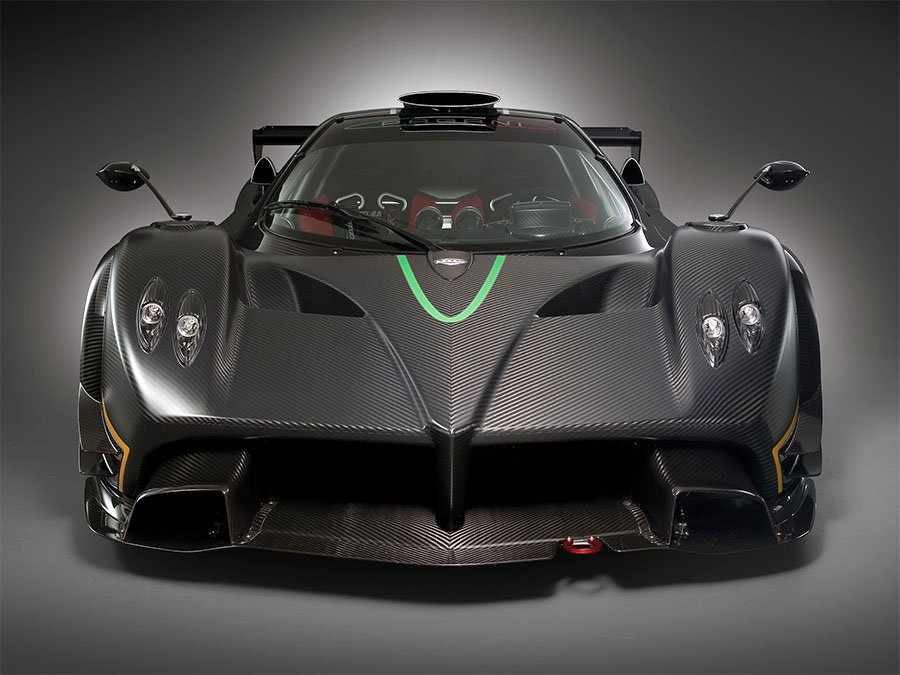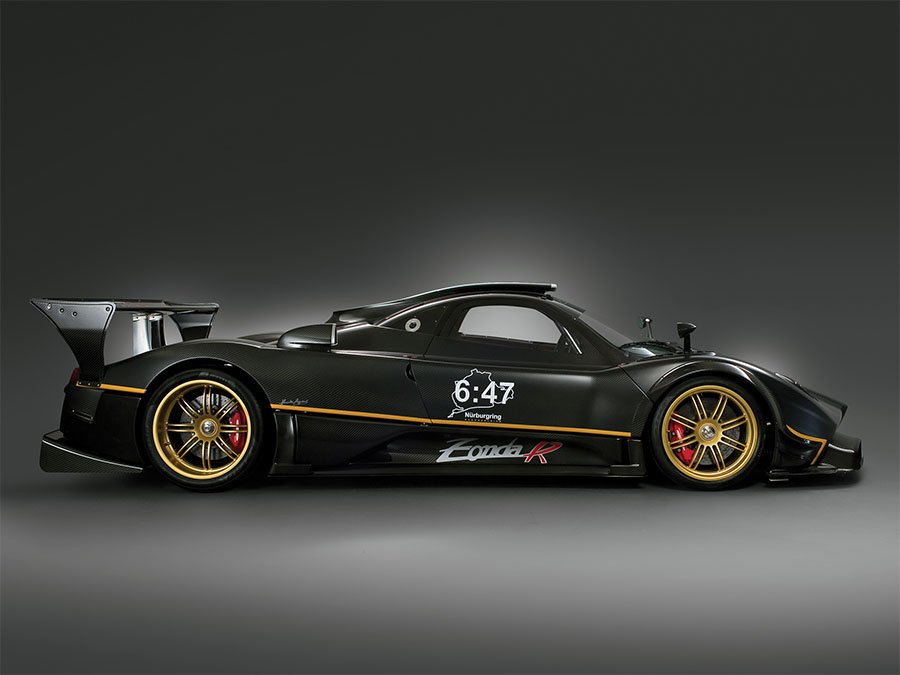Guide: Pagani goes FXX with the Zonda - a Historical & Technical Appraisal of the Zonda R
/BACKGROUND
Five-and-a-half years after the Zonda made its world debut, Pagani unveiled a one-off track-focussed version dubbed the Monza at the Paris Motor Show in October 2004.
Commissioned by an existing customer from the USA, the Zonda Monza featured stiffer suspension with manually adjustable dampers and anti-roll bars, bigger brake discs with uprated calipers, centre-lock instead of five-bolt wheels and an FIA fuel cell.
The Monza’s 7.3-litre engine was enhanced with a dry-sump lubrication system, a re-mapped Motec ECU, improved cooling and an un-silenced exhaust. Externally, an array of custom cooling and aero solutions were added while the cockpit was stripped to the bone and furnished with competition-grade equipment to include an aluminium rollcage.
At 1100kg, the Monza was the lightest Zonda yet and tipped the scales at an extraordinary 150kg less than a contemporary 7.3-litre S.
Eight months later in June 2005, Ferrari revealed an even more extreme interpretation of their recently discontinued Enzo flagship: the FXX.
Significantly enhanced in every department, like the Zonda Monza the wild-looking FXX was conceived exclusively for track use, but once again without any specific racing regulations in mind which enabled the designers total freedom when it came to creating the most radical machine possible.
A production run of 20-or-so examples was anticipated with each FXX customer invited to use their machine at a series of exclusive international-level track events organised by Ferrari where an official team of works technicians would be on hand to provide all the technical assistance required.
No doubt inspired by these ever more extreme interpretations of the fastest cars on the planet, during early 2006 one of Pagani’s best customers ordered the ultimate Zonda with an almost money-no-object philosophy.
The resultant Zonda R was a machine said to be 90% new compared to a contemporary Zonda F. Pagani originally anticipated 15 customer units would be built, the prototype for which broke cover at the Geneva Motor Show in March 2007.
22 months later in January 2009, the production Zonda R was unveiled at the Vienna Motor Show.
CHASSIS
Each Zonda R was based around a revised composite tub fashioned from a unique combination of carbonfibre bonded with strands of titanium. Lighter and stiffer than ever before, rigidity was further enhanced thanks to an integrated chrome moly roll cage.
Redesigned chrome moly subframes were attached at either end in order to incorporate new suspension geometry.
As usual, the front subframe supported the suspension, power-assisted steering box and various auxiliary systems and was deformable in the event of a frontal impact. The rear subframe partially supported the engine (which was now bolted directly to the tub) along with the transaxle gearbox and suspension.
At 2785mm, the R’s wheelbase (which had been extended to aid stability) was 55mm longer than a regular Zonda.
Instead of magnesium alloy (as used on the Zonda F), the Zonda R’s trick lightweight suspension arms were fabricated from forged Avionel. Double wishbones were fitted all round along with pull rod helical springs, adjustable Ohlins dampers and an adjustable anti-roll bar at either end.
The 380mm carbon-ceramic front brake discs available on the Zonda F (where 355mm diameter discs were used at the rear) were fitted to all four corners of the Zonda R. Four-piston calipers were also installed along with hydraulic power-assistance and custom-mapped Bosch Motorsport ABS software.
Rose-gold forged magnesium APP wheels used a centre-lock as opposed to five-bolt attachment. As per the Zonda F, they measured 9 x 19 inches up front and 13 x 20-inches at the back. Slick tyres were a special Pirelli P Zero compound developed specifically for the Zonda R (255/35/19 front and 335/20/20 rear).
Track dimensions were 50mm wider all round compared to a Zonda F and pneumatic air jacks were fitted for easy wheel changes.
Mounted in the lower section behind the cockpit was a new FIA rubber fuel cell with four pumps and a brace of quick filler caps.
ENGINE / TRANSMISSION
In the engine bay was an uprated version of AMG’s Type GT 112 power unit. This was itself an evolution of the Mercedes-Benz M120 lump: an all-alloy 60° V12 with dual overhead camshafts per bank and four valves per cylinder.
Developed for use in the FIA GT Championship and at the Le Mans 24 Hours (where a six-litre displacement limit applied for GT1 cars), the GT 112 motor had originally been enhanced with an array of upgrades to include dry-sump lubrication, titanium connecting rods, a higher compression ratio (increased from 10.0:1 to 12.0:1) and re-mapped Bosch sequential fuel-injection.
Overall displacement came in at 5987cc thanks to a bore and stroke of 89mm and 80.2mm respectively.
As a consequence of the air restrictors mandated by period GT regulations, peak output was 600bhp at 7000rpm and 516lb-ft at 3900rpm.
More than a decade on, and with no rulebook to comply with, Pagani managed to substantially raise those headline figures.
The original Bosch fuel-injection was switched to a new SFI system and twelve mechanically-operated throttle bodies were installed. A roof-mounted snorkel provided a slight ram effect in conjunction with Pagani’s own carbonfibre intake system. An un-silenced F1-style hydroformed exhaust was fashioned from ceramic-coated Inconel 625.
All told, in this un-restricted state,peak output rose to 739bhp at 7500rpm and 524lb-ft at 5700rpm.
The gearbox was a longitudinally-mounted Xtrac 672 six-speed sequential gearbox housed in a light weight magnesium casing. Shift times took just 20 milliseconds.
Transmission was through a racing multi-disc clutch, a self-locking limited-slip differential and Bosch Motorsport traction control system that offered twelve different drive modes.
BODYWORK
Owing to its extended nose and dramatic underfloor diffuser, the Zonda R came in 451mm longer than a Zonda F. The new car’s body panels were given a distinctive matt exposed carbonfibre finish whereas the spoilers and skirts were gloss.
The overall package was conceived with a view to creating maximum downforce and, to that end, the underbody was almost completely enclosed.
At the leading edge of the single-piece front clip (which was separate to the enormous new splitter) Pagani added dramatically enlarged intake nostrils for the radiators and brakes. Further up was a more aggressively contoured delta that swept all the way towards the front bulkhead where it was flanked by two huge cooling vents. More new vents were added atop the front fenders and smaller high-intensity projector headlights were installed along with dual canards per side and bulbous flares to cover the front wheels / tyres.
With the front clip detached, all-new carbonfibre ducting was exposed.
Instead of a glass roof, the Zonda R featured a carbon roof complete with an intake snorkel that fed fresh air to the engine. Additional snorkels were mounted on the rear fenders for cooling the brakes. The rear quarter windows were blanked off to accommodate a quick fuel filler cap on each side.
Down each flank were more prominent skirts with air guides at either end.
The rear clip was longer, smoother and even more intricately shaped than before. At the back was an adjustable spoiler mounted on two central pylons and with endplates that connected to the trailing edge of the rear bodywork.
The rear fascia was completely redesigned and, aside from a pair of structural black mesh grilles, left almost entirely open. In addition to the massive rear spoiler, the view from behind was dominated by the Zonda R’s enormous eight-blade diffuser.
INTERIOR
Inside, the R came with practically none of high end fixtures and fittings that had come to characterise the Zonda since its launch back in 1999.
Although aspects of the trademark Zonda dash remained, it was now much-modified to incorporate the aforementioned roll cage while the original analogue instrument binnacle was replaced with a Digitek screen through which all the cars’ data and telemetry systems could be accessed.
Ahead of this screen was a new alcantara-rimmed carbonfibre steering with integrated switchgear for adjustment of the car’s settings along with a pair of massive exposed carbonfibre gearshift paddles.
Instead of the well-padded two-piece original seats with their mix of plain leather and diamond quilting, HANS compatible racing seats were installed. These were tailored to the first owner and trimmed with leather bolsters and alcantara centres. Five-point Zonda R-branded harnesses were also fitted.
Gone as well was the quilted leather that normally covered the footwells, forward section of the transmission tunnel and the rear bulkhead. The ribbed leather door panels were ditched too and all of these surfaces left in exposed carbonfibre.
The transmission tunnel itself was completely redesigned.
OPTIONS
No options were officially offered for the Zonda R although buyers could tailor their car in terms of body, wheel and trim colour if desired.
WEIGHT / PERFORMANCE
At a quoted 1070kg, the Zonda R weighed in at 170kg less than a standard Zonda F.
Top speed went from 217mph to 233mph and the 0-62mph time dropped from 3.5 to 2.8 seconds.
In July 2010, Pagani test driver Marc Basseng set a new lap record for production-based cars at the Nurburgring with a time of 6 minutes 47 seconds. This was eleven seconds faster than the previous best (set by a Ferrari FXX) and a fraction over 40 seconds quicker than Basseng had gone with a Zonda F Club Sport.
END OF PRODUCTION
Although Pagani had originally hoped to sell 15 examples of the Zonda R, after the prototype only ten customer units were ultimately completed between 2009 and 2010, most likely as a consequence of the depressed economic conditions following the 2008 financial crisis.
At the Goodwood Festival of Speed in June 2012, a subsequent evolution of the Zonda R dubbed the Zonda Revolucion was unveiled.
Text copyright: Supercar Nostalgia
Photo copyright: Pagani - https://www.pagani.com/




















